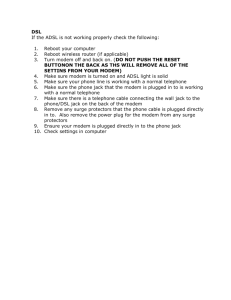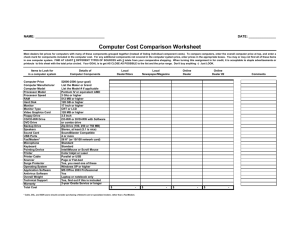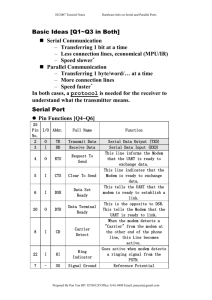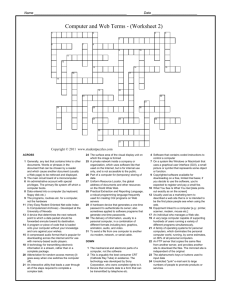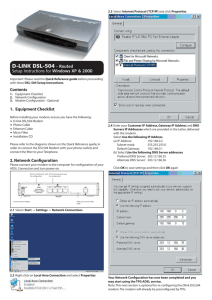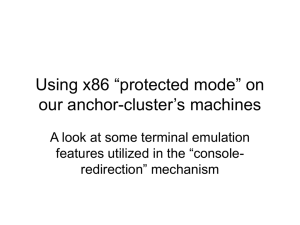uart 16450 compatible macro
advertisement
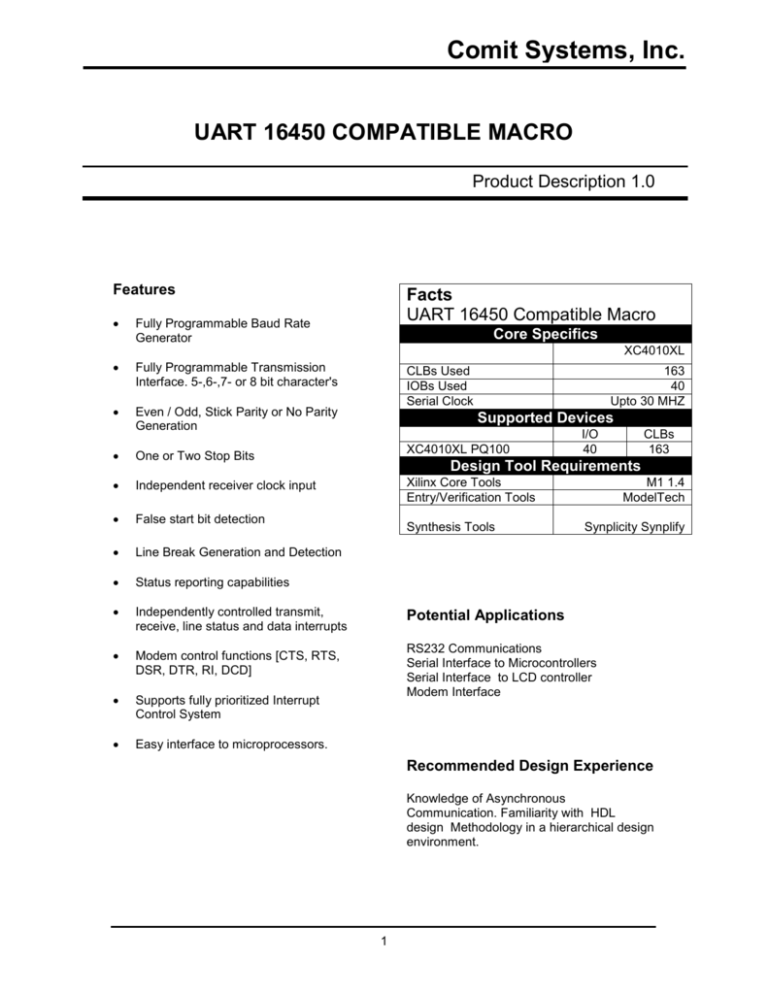
Comit Systems, Inc. UART 16450 COMPATIBLE MACRO Product Description 1.0 Features Facts UART 16450 Compatible Macro Fully Programmable Baud Rate Generator Core Specifics XC4010XL Fully Programmable Transmission Interface. 5-,6-,7- or 8 bit character's Even / Odd, Stick Parity or No Parity Generation One or Two Stop Bits Independent receiver clock input False start bit detection Line Break Generation and Detection Status reporting capabilities Independently controlled transmit, receive, line status and data interrupts Modem control functions [CTS, RTS, DSR, DTR, RI, DCD] Supports fully prioritized Interrupt Control System Easy interface to microprocessors. CLBs Used IOBs Used Serial Clock 163 40 Upto 30 MHZ Supported Devices XC4010XL PQ100 I/O 40 CLBs 163 Design Tool Requirements Xilinx Core Tools Entry/Verification Tools Synthesis Tools M1 1.4 ModelTech Synplicity Synplify Potential Applications RS232 Communications Serial Interface to Microcontrollers Serial Interface to LCD controller Modem Interface Recommended Design Experience Knowledge of Asynchronous Communication. Familiarity with HDL design Methodology in a hierarchical design environment. 1 Interrupt cntrl intr out_data in_data tx_uart address(0) sout address(1) address(2) rts_l cs1 cts_l cs1 cs2_l cpu_top modem_if dtr_l dsr_l ads_l dcd_l reset ri_l read_l rx_uart write_l ddis_l rclk sin csout xin baudout_clk baud_gen Figure 1. 16450 Compatible UART Block Diagram Rx_uart Module This module receives serial data and converts it to parallel data. The data received is stored in the buffer. General Description The UART Macro is divided in six submodules. Each can be optimized depending upon the target application. The CPU interface can be optimized depending upon the type of microcontroller interface required. Modem_if module This module provides interface to modem signals. Functional Description Baud_gen module The baud_gen module generates required baud for transmitting the data. Cpu_top Module This module interfaces to parallel bus/ microcontroller and generates chipselects and read/write signals for internal UART registers. This module can be customized to any asynchronous/synchronous bus interface. the Core Modifications The 16450 compatible macro core design is modular, making modifications is relatively simple. If you are interested in obtaining a version of the core that is different from this product description, then contact Comit Systems directly. Comit Systems can provide custom version of core, including the changes in microprocessor interface, changes in line interface and adding the additional features required. Tx_uart Module This Module converts parallel data to serial according to the serial format programmed in the LCR register and transmits over a serial line. 2 Signal Name Pinouts Type The pinout of the UART has not been fixed to specific FPGA I/O allowing flexibility with user application. The signal names are provided in the Table 1 below. Signal Name Reset Address Type Input Input In_data Input ads_l Input Read_l Input write_l Input cs0 Input cs1 Input cs2_l Input cts_l Input Dcd_l Input Description Global reset signal Address lines. address(0), address(1) and address(2) are three inputs used during Read rd_l and Write wr_l operations to read from or write into to select the ACE register [from internal Register Bank] . in_data(7-0) and out_data(7-0) are the unidirectional input and output data lines that provide out_data(7-0) a bidirectional path for data, control and status information between the ACE and the CPU. Address Strobe. The positive edge of the ads_l signal latches the ACE Register select ( address 0 - 2 ) and Chip Select ( cs0,cs1,cs2_l ) signals When read_l is low while the core is read_l Input selected, the CPU can read status information or data from the selected UART registers [register bank]. When write_l is low while the core is write_l Input selected, the CPU can write control words or data into the selected UART registers [register bank]. Output to the tx_uart block which indicates that transmitter holding register is full. Chip Select. When cs0 , cs1 are high and cs2_l low , the ACE is selected. Chip Select. When cs0 , cs1 are high and cs2_l low , the ACE is selected. cts_l is a modem status signal. Its condition can be checked by reading bit 4 of the modem status register. Bit 0 of the modem status cts_l . Input register indicates that this signal had changed state since the last read from the modem status register. It the modemstatus interrupt is enabled when cts_l changes state, an interrupt is generated. dcd_l is a modem status signal. Its condition can be 3 ddis_l Input Dsr_l Output Dtr_l Output Out_data Output Intr Output Rclk Input Ri_l Input Description checked by reading bit 7 of the modem status register. Bit 3 of the modem status register indicates that this signal had changed state since the last read from the modem status register. It the modemstatus interrupt is enabled when dcd_l changes state, an interrupt is generated. when the CPU is not reading data. This output can be used to disable the drivers. dsr_l is a modem status signal. Its condition can be checked by reading bit 5 of the modem status register. Bit 1 of the modem status register indicates that this signal had changed state since the last read from the modem status register. It the modem status interrupt is enabled when dsr_l changes state, an interrupt is generated. Data terminal ready. When asserted, dtr_l informs a modem or a data set that the ACE is ready to establish communication. dtr_l is placed in active state by setting DTR bit of the modem control register to a high level. dtr_l is deasserted by clearing DTR bit of the modem control register. in_data(7-0) and out_data(7-0) are the unidirectional input and output data lines that provide out_data(7-0) a bidirectional path for data, control and status information between the ACE and the CPU. This pin goes high when whenever any one of the following interrupt types has an active high condition and is enabled via the IER. Receiver Error Flag, Received Data Available, Transmitter Holding Register Empty, and Modem Status. The INTR signal is reset low upon the appropriate interrupt service or a Master Reset Operation. Receive Clock. This input is the 16 X baud rate clock for the receiver section of the chip. When low this indicates that the telephone ringing signal has been received by the Modem. The ri_l signal is a Modem Status input whose condition can be tested by the CPU reading bit 6(RI) of the Modem Status Register. Bit 6 is the compliment of the ri_l Signal Name Type Rts_l Input sin Input sout Output xin csout Input Output Description signal. Bit 2 of the Modem Status Register indicates whether the ri_l input signal has changed from a low to a high state since the previous reading of the Modem Status Register. Request to Send. When low this informs the Modem or Data Set that the UART is ready to exchange data. The rts_l output can be set to an active low by programming bit 1 (RTS) of the Modem Control Register. Serial input. Serial Data Input from the communications link (peripheral device, Modem or Data Set). Serial Output. Composite serial data output to the communications link (peripheral, Modem or data set). The SOUT signal is set to the Marking Logic 1 state upon a Master Reset Operation. External Crystal Input. Chip Select Out. When asserted, indicates the core has been selected by assertion of the chip select inputs. Verification Models The 16450 compatible UART has been extensively tested using the testbench developed at Comit Systems. The test bench is also available with the core. Comit Systems, Inc. 3375 Scott Blvd. Ste 139 Santa Clara, CA 95054, USA. Phone: +1 (408) 988-2988 URL: http://www.comit.com FOR MORE INFORMATION CLICK THE REQUEST QUOTE LINK ON WEBSITE 4

